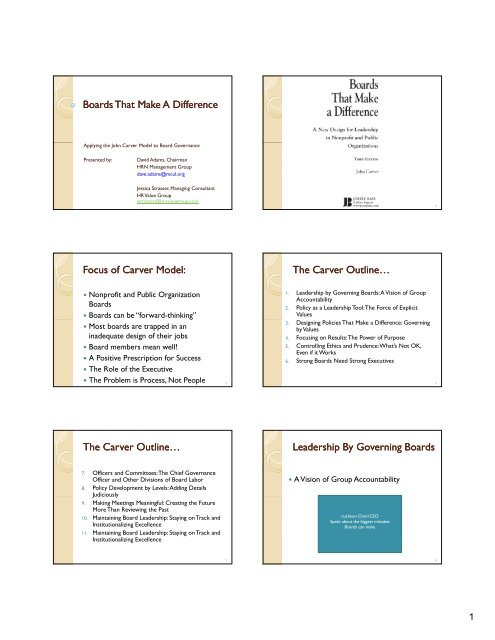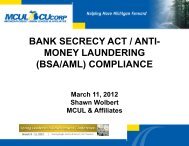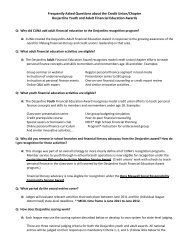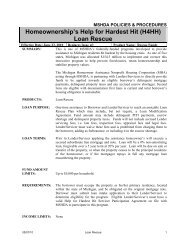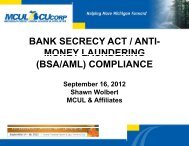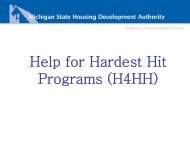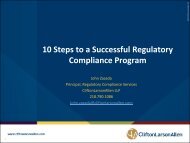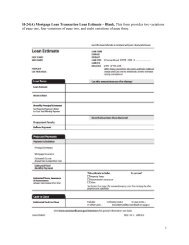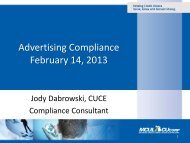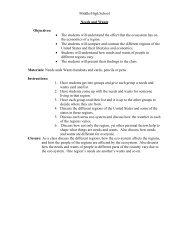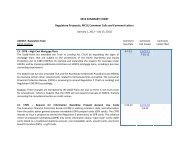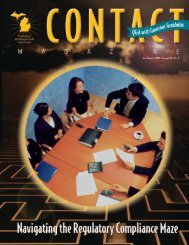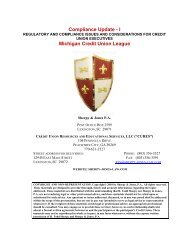Boards That Make A Difference Focus of Carver Model: The Carver ...
Boards That Make A Difference Focus of Carver Model: The Carver ...
Boards That Make A Difference Focus of Carver Model: The Carver ...
Create successful ePaper yourself
Turn your PDF publications into a flip-book with our unique Google optimized e-Paper software.
<strong>Boards</strong> <strong>That</strong> <strong>Make</strong> A <strong>Difference</strong><br />
Applying the John <strong>Carver</strong> <strong>Model</strong> to Board Governance<br />
Presented by:<br />
David Adams, Chairman<br />
HRN Management Group<br />
dave.adams@mcul.org<br />
Jessica Strasser, Managing Consultant<br />
HR Value Group<br />
jstrasser@hrvaluegroup.com<br />
2<br />
<strong>Focus</strong> <strong>of</strong> <strong>Carver</strong> <strong>Model</strong>:<br />
• Nonpr<strong>of</strong>it and Public Organization<br />
<strong>Boards</strong><br />
• <strong>Boards</strong> can be “forward-thinking”<br />
• Most boards are trapped in an<br />
inadequate design <strong>of</strong> their jobs<br />
• Board members mean well!<br />
• A Positive Prescription for Success<br />
• <strong>The</strong> Role <strong>of</strong> the Executive<br />
<strong>The</strong> <strong>Carver</strong> Outline…<br />
1. Leadership by Governing <strong>Boards</strong>: A Vision <strong>of</strong> Group<br />
Accountability<br />
2. Policy as a Leadership Tool: <strong>The</strong> Force <strong>of</strong> Explicit<br />
Values<br />
3. Designing Policies <strong>That</strong> <strong>Make</strong> a <strong>Difference</strong>: Governing<br />
by Values<br />
4. <strong>Focus</strong>ing on Results: <strong>The</strong> Power <strong>of</strong> Purpose<br />
5. Controlling Ethics and Prudence: What’s Not OK,<br />
Even if it Works<br />
6. Strong <strong>Boards</strong> Need Strong Executives<br />
• <strong>The</strong> Problem is Process, Not People<br />
3<br />
4<br />
<strong>The</strong> <strong>Carver</strong> Outline…<br />
Leadership By Governing <strong>Boards</strong><br />
7. Officers and Committees: <strong>The</strong> Chief Governance<br />
Officer and Other Divisions <strong>of</strong> Board Labor<br />
8. Policy Development by Levels: Adding Details<br />
Judiciously<br />
9. Making Meetings Meaningful: Creating the Future<br />
More Than Reviewing the Past<br />
10. Maintaining Board Leadership: Staying on Track and<br />
Institutionalizing Excellence<br />
11. Maintaining Board Leadership: Staying on Track and<br />
Institutionalizing Excellence<br />
• A Vision <strong>of</strong> Group Accountability<br />
nuUnion Chair/CEO<br />
Speak about the biggest mistakes<br />
<strong>Boards</strong> can make<br />
5<br />
6<br />
1
What Can Go Wrong?<br />
Broad Assessment<br />
• Time spent on the trivial<br />
• Reading reams <strong>of</strong> documents<br />
• Long-running meetings that accomplish little<br />
• Committees that are window dressing for what staff<br />
want to do<br />
• Meddling in administration<br />
• Staff in control <strong>of</strong> board agendas<br />
• Reactivity vs. Proactivity<br />
• Executive committee as de facto Board<br />
• Confusing about what is going on<br />
• Rubber stamping or Meddling<br />
• No incisive way to evaluate the Executive<br />
• “Most <strong>of</strong> what the majority <strong>of</strong> boards do<br />
either does not need to be done or is a<br />
waste <strong>of</strong> time when done by the Board.<br />
Conversely, most <strong>of</strong> what boards need<br />
to do for strategic leadership is not<br />
done.”<br />
7<br />
8<br />
What is Governance?<br />
• “Reduced to its minimum, the purpose <strong>of</strong><br />
governance is to ensure, usually on behalf<br />
<strong>of</strong> others, that an organization (credit<br />
union) achieves what it should achieve<br />
while avoiding those behaviors and<br />
situations that should be avoided.”<br />
What Should <strong>Boards</strong> Do?<br />
1. Hire, evaluate and retain a good CEO<br />
2. Provide strategic direction to the CEO<br />
3. Establish, maintain and operate within<br />
governance policies<br />
4. Provide fiduciary stewardship for and on<br />
behalf <strong>of</strong> the member-owners<br />
GOVERNANCE POLICIES HELP WITH,<br />
BUT DO NOT REPLACE THESE DUTIES<br />
9<br />
10<br />
Does Your Board Need This?<br />
• <strong>Carver</strong> model is for the best <strong>of</strong> today’s boards, not<br />
just for dysfunctional ones.<br />
• Why is it particularly relevant to credit unions?<br />
• What is unique about not-for-pr<strong>of</strong>it (nonpr<strong>of</strong>it)<br />
boards vs. for-pr<strong>of</strong>it or government boards?<br />
• How is success defined?<br />
• Producing What Owners Want<br />
What Can Go Wrong?<br />
• Short-term bias<br />
• Reactive stance<br />
• Reviewing, rehashing, redoing<br />
• Leaky accountability (meddling)<br />
• Unclear boundaries <strong>of</strong> authority<br />
• Complete overload<br />
11<br />
12<br />
2
Moving Toward Solutions<br />
Policy as a Leadership Tool:<br />
• Framing the Governance Challenge<br />
• Inadequate Prescriptions<br />
◦ More involvement<br />
◦ Less involvement<br />
◦ Board as staff watchdog<br />
◦ Board as cheerleader<br />
• Proper Prescriptions<br />
◦ Board as manager (<strong>of</strong> the CEO)<br />
◦ Board as planner (with the CEO)<br />
◦ Board as adviser (for the CEO)<br />
◦ Board as fundraiser (for the CU)<br />
◦ Board as communicator (with the CEO)<br />
◦ Board as Trustees (for the members)<br />
◦ Board Holism (for the CEO)<br />
• <strong>The</strong> Force <strong>of</strong> Explicit Values<br />
nuUnion Chair/CEO<br />
Speak about how Policy Governance<br />
<strong>Make</strong>s boards effective<br />
13<br />
14<br />
Policy as a Leadership Tool<br />
• Policies as Values and Perspectives<br />
• Four Reasons for Policy Leadership<br />
1. Leverage and efficiency<br />
2. Expertise<br />
3. Fundamentals<br />
4. Vision and inspiration<br />
• Reinventing the Meaning <strong>of</strong> Policy<br />
• Categories <strong>of</strong> Board Policy:<br />
1. Ends to be achieved (Service Needs)<br />
2. Means to be avoided (Executive Limitations)<br />
3. Board-CEO Relationship<br />
4. Governance Process<br />
Designing Policies <strong>That</strong> <strong>Make</strong> a <strong>Difference</strong>:<br />
• Governing by Values<br />
15<br />
16<br />
Designing Policies<br />
• Get Rid <strong>of</strong> Unnecessary and Outdated Detail While<br />
Being Comprehensive<br />
• <strong>Make</strong> Policies Visible, Explicit, Literal, Active, Properly<br />
Classified, Centrally Available and Brief<br />
• Move Broad to Specific and Large to Small (Prioritize)<br />
• Set Board Policy, not Staff Policy<br />
• Hold CEO Accountable for Staff Policies<br />
<strong>Focus</strong>ing on Results:<br />
• <strong>The</strong> Power <strong>of</strong> Purpose<br />
17<br />
18<br />
3
<strong>Focus</strong>ing on Results<br />
• Define Mission & Purpose<br />
• Resist the Captivating Allure <strong>of</strong><br />
Organizational Events/Issues<br />
• Stay Outward <strong>Focus</strong>ed<br />
• Transaction With the Environment<br />
• If not “Ends”, it is “Means”<br />
• <strong>The</strong> Mask <strong>of</strong> Commendable Activities,<br />
Conditions, Structure, Technology, Etc.<br />
Compelling “Ends” Policies<br />
• Strict Results <strong>Focus</strong><br />
• Succinctness<br />
• Active Board Involvement in “Ends”<br />
• Accountability to Owners/Members<br />
• Properly Categorized<br />
• <strong>The</strong>me and Backbone <strong>of</strong> the CU<br />
• Stark and Direct<br />
• Global Purpose, Followed by Policies About Results, How<br />
Members Benefit, Pricing, Etc.<br />
• Integration With Long-Range Planning<br />
• Evaluating Ends With Key Performance Measures<br />
• Again, Broad-to-Specific and Large-to-Small<br />
19<br />
20<br />
Examples <strong>of</strong> Ends or Service Needs Policies<br />
Sample “Ends” or “Service Needs” Policy<br />
21<br />
22<br />
Board Discussion<br />
• How can we apply the concept <strong>of</strong> Service<br />
Needs (Ends) Policies to our credit<br />
union?<br />
◦<br />
◦<br />
◦<br />
◦<br />
◦<br />
◦<br />
Controlling Ethics and Prudence:<br />
• What’s Not OK, Even if It Works<br />
23<br />
24<br />
4
Controlling Ethics and Prudence<br />
Examples <strong>of</strong> Executive Limitations Policies<br />
• Manage between Rubber-stamping and Meddling<br />
• Avoid the Enticement <strong>of</strong> Operations<br />
• <strong>The</strong> Board’s Interest: Effectiveness, Approvability,<br />
Legitimate Control <strong>of</strong> Means, <strong>Focus</strong> on Prudence &<br />
Ethics<br />
• This Category is Executive Limitations Policies<br />
• Board Prescription <strong>of</strong> Means is “Anti-Innovative”<br />
and “Stultifying”<br />
• Start Broad-to-specific and Large-to-small<br />
• Transform Worries Into Policies<br />
• Limitation, Not Empowerment<br />
25<br />
26<br />
Sample “Executive Limitations” Policy<br />
Board Discussion<br />
• How can we apply the concept <strong>of</strong><br />
Executive Limitation Policies to our credit<br />
union?<br />
◦<br />
◦<br />
◦<br />
◦<br />
◦<br />
◦<br />
27<br />
28<br />
Strong <strong>Boards</strong> Need Strong Executives:<br />
• <strong>The</strong> Board-Executive Relationship<br />
nuUnion Chair/CEO<br />
Speak about developing mutual<br />
trust between the board and CEO<br />
Strong <strong>Boards</strong> Need Strong Executives<br />
• <strong>The</strong> Most Important Task <strong>of</strong> the Board<br />
• Defining a CEO<br />
• Nonpr<strong>of</strong>its vest Chairman and CEO separately, unlike<br />
for-pr<strong>of</strong>its<br />
• Board Holism – Accountability<br />
• <strong>The</strong> Board Has Only One Employee<br />
• <strong>The</strong> CEO’s Work is Immaterial<br />
• Board Members and CEO are Colleagues<br />
29<br />
30<br />
5
Monitoring CEO Performance<br />
Keeping the Roles Separate<br />
• Types <strong>of</strong> Information<br />
◦ Decision Information (Helps Board make decisions)<br />
◦ Monitoring Information (Goal attainment)<br />
◦ Incidental Information (Less important)<br />
• Methods <strong>of</strong> Monitoring<br />
◦ Annual Evaluation<br />
◦ Regular Reports<br />
• Criteria for Monitoring<br />
◦ Stay focused: Save board/staff time<br />
◦ Have clear criteria<br />
◦ Two-step: Compare results to policy.<br />
• Executive Recommendations<br />
• Intrusions by the Board<br />
• Mutual Expectations<br />
• Board-Management Delegation<br />
31<br />
32<br />
Examples <strong>of</strong> Board-CEO Relationship<br />
Policies<br />
Sample Board-CEO Policy:<br />
33<br />
34<br />
Board Discussion<br />
• How can we apply the concept <strong>of</strong><br />
Board/CEO Relationship Policies to our<br />
credit union?<br />
◦<br />
◦<br />
◦<br />
◦<br />
◦<br />
◦<br />
<strong>The</strong> Board’s Responsibility for Itself:<br />
• Governing Oneself Precedes Governing<br />
Others<br />
nuUnion Chair/CEO<br />
Speak about the meddling/rubber<br />
stamping balance<br />
35<br />
36<br />
6
Board Accountability<br />
• <strong>The</strong> Moral Ownership<br />
• <strong>The</strong> Board’s Responsibility for Board<br />
Performance<br />
• Diversity and Dynamics<br />
• Board Products: A Job Description,<br />
Explicit Governing Policies and Assurance<br />
<strong>of</strong> Organizational Performance<br />
Basic Board Job Description<br />
• Linkage to the Ownership<br />
• Explicit Governance Policies<br />
• Assurance <strong>of</strong> Organizational Performance<br />
• Other Duties (Fundraising, public image,<br />
legislative impact, etc.)<br />
37<br />
38<br />
Officers and Committees:<br />
• <strong>The</strong> Chief Governance Officer and<br />
Other Divisions <strong>of</strong> Board Labor<br />
Officers and Committees<br />
• Duties <strong>of</strong> Officers<br />
• Minimalism<br />
• Chief Governance Officer vs. Chief<br />
Executive Officer<br />
• Protection <strong>of</strong> the CEO Role<br />
• Board Holism<br />
• Committees: Minimalism and Pre-work vs.<br />
Post-work<br />
39<br />
40<br />
Policy Development by Levels:<br />
• Adding Details Judiciously<br />
Policy Development<br />
• <strong>The</strong> Crucial <strong>Difference</strong> Between Levels<br />
and Lists<br />
• Form and Function<br />
◦ Participation & Voting<br />
◦ Decision Information<br />
◦ Everything in its Place<br />
◦ Proceeding from the Top Down<br />
◦ Meticulous Care<br />
◦ Role <strong>of</strong> the CEO in Policy Development<br />
41<br />
42<br />
7
Making Meetings Meaningful:<br />
• Creating the Future More Than<br />
Reviewing the Past<br />
Making Meetings Meaningful<br />
• Managing a Talking Job<br />
• Choosing the Issues<br />
• Screening Form Before Content<br />
• Being Ready for Discussion<br />
• Rbb Rubber-stamping vs. Meddling<br />
• Tradition & Law<br />
• Planning the Agenda – Tie to the Long-term<br />
• Ends Justify the Meetings<br />
• Managing the Transition<br />
• Unity in Board Purpose Despite Diversity<br />
• <strong>The</strong> Character <strong>of</strong> Meetings<br />
43<br />
44<br />
Examples <strong>of</strong> Board Process Policies:<br />
Sample Board Process Policy:<br />
45<br />
46<br />
Board Discussion<br />
• How can we apply the concept <strong>of</strong> Board<br />
Process Policies to our credit union?<br />
◦<br />
◦<br />
◦<br />
◦<br />
◦<br />
◦<br />
Maintaining Board Leadership:<br />
• Staying on Track and Institutionalizing<br />
Excellence<br />
nuUnion Chair/CEO<br />
Speak about how boards<br />
Can make a difference<br />
47<br />
48<br />
8
Maintaining Board Leadership<br />
• Be Obsessed with Effects for People<br />
• Invigorate the Ends Debate<br />
• Drive Ends Dialogue Beyond the Boardroom<br />
• Don’t Be Seduced by Cost Control<br />
• Keep Trusteeship Up Front<br />
• Respect your Words<br />
• Invest in Selection & Training<br />
• Recruit Those Who Can and Will Govern<br />
• Commit to Structured Practice<br />
• <strong>Make</strong> Self-Evaluation a Regular Event<br />
Parting Thoughts<br />
• Realize that Good Begets Better and<br />
Clarity Begets Trust<br />
• Never Forget that Governance is a Means<br />
• Excellence Begins in the Boardroom<br />
• One Size Can’t Fit All<br />
49<br />
50<br />
Board Discussion<br />
• What are the next steps for applying<br />
Policy Governance in our credit union?<br />
◦<br />
◦<br />
◦<br />
◦<br />
◦<br />
◦<br />
Additional Resources<br />
• HR Value Group Consulting<br />
• CUcorp’s “Policy Pro” Governance<br />
Module<br />
• John <strong>Carver</strong>’s “<strong>Boards</strong> <strong>That</strong> <strong>Make</strong> a<br />
<strong>Difference</strong>”<br />
• CU commitment to Board training with<br />
MCUL, CUNA and Others<br />
51<br />
52<br />
<strong>Boards</strong> <strong>That</strong> <strong>Make</strong> A <strong>Difference</strong><br />
Applying the John <strong>Carver</strong> <strong>Model</strong> to Board Governance<br />
Presented by:<br />
David Adams, Chairman<br />
HRN Management Group<br />
dave.adams@mcul.org<br />
Jessica Strasser, Managing Consultant<br />
HR Value Group<br />
jstrasser@hrvaluegroup.com<br />
9


